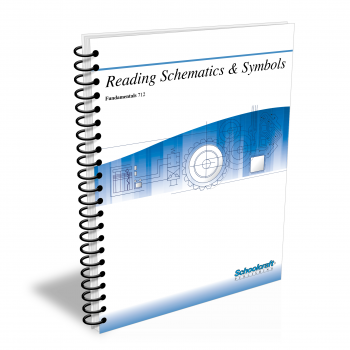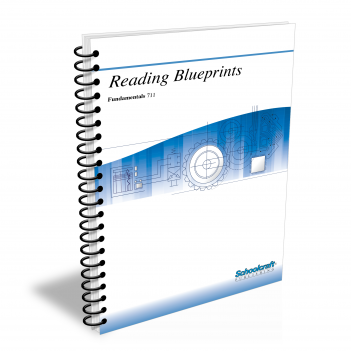Reading Schematics & Symbols

Course Number: 712
After introducing the concepts of what symbols mean and how they are used in conveying technical information, the Reading Schematics & Symbols textbook shows how the general principles are applied for specific purposes. The various chapters focus on electrical, fluid power, and air conditioning, and welding diagrams. Each is well illustrated with examples of technical diagrams similar to those the student will see in each discipline.
Does your curriculum require additional topics not included in this textbook? Build a customized version of the Reading schematics & Symbols textbook below.
This textbook has been recently updated
to include topics lists, objectives, & key terms for every chapter.
Recommended Contact Hours – 15
Preview a Chapter
Available Supporting Material
- Table of Contents
- Exam Copies
- Suggested Titles
Table of Contents
Chapter 1: Introduction to Technical Diagrams
Topics: Using schematics; Electrical, pneumatic, hydraulic, and piping schematics; Looking for flow; Electrical current; Fluid flow
Learning Objectives:
- State the definition of a schematic.
- List some characteristics of schematics.
- Identify a schematic among other kinds of technical drawings and diagrams.
- Explain how flow is indicated on a schematic.
Chapter 2: Symbols on Schematics
Topics: Common features in schematics; Creating and using the schematic; Identifying symbols and connections; Reading diagrams
Learning Objectives:
- Identify various types of lines on schematics
- Identify the following schematics by their symbols:Electrical
Fluid-power
Piping - Give the purpose of legends and other tables of symbols.
- Describe a set-by-step approach to troubleshooting when using a schematic.
Chapter 3: Electrical Symbols
Topics: Wires and connections; Switches; Power supply; Electrical loads; Coils and transformers; Fuses and circuit breakers; Grounding; Contacts; Resistors; Symbols in a diagram
Learning Objectives:
- State the meaning of symbols and lines on an electrical schematic.
- Explain the difference between a fuse and a circuit breaker.
- Explain how to trace an electrical circuit.
Chapter 4: Electrical Diagrams
Topics: Schematic and wiring diagrams; Series and parallel circuits; Reading electrical diagrams and industrial schematics
Learning Objectives:
- Explain the difference in current flow between a series circuit and a parallel circuit.
- Explain the purpose of a wiring diagram.
- Demonstrate how to read an electrical schematic.
- Identify the objects represented by the symbols on an industrial schematic.
Chapter 5: Piping Symbols
Topics: Piping systems; Kinds of diagrams; Projections; Joints; Fittings; Symbols
Learning Objectives:
- Explain the function of a valve in a piping system.
- Name the ways of joining pipe.
- Identify the symbols for various kinds of fittings and describe the function of each fitting.
Chapter 6: Piping Diagrams
Topics: Piping systems; Valves; Identifying symbols; Reading a piping schematic
Learning Objectives:
- Give the purpose of a valve in a piping system.
- Explain the difference between a check valve and a cock valve.
- Identify the symbols for various types of valves.
- Demonstrate the ability to determine pipe size from a diagram.
Chapter 7: Hydraulic and Pneumatic Symbols
Topics: Fluid power; Reservoirs and receivers; Pumps and compressors; Actuators; Valves; Piping and tubing
Learning Objectives:
- Describe a fluid-power system.
- List and give the purpose of the main parts of a hydraulic system.
- List and give the purpose of the main parts of a pneumatic system.
- Identify pneumatic and hydraulic symbols on schematics.
Chapter 8: Hydraulic and Pneumatic Diagrams
Topics: Composite symbols; Understanding circuits; Hydraulic and pneumatic circuit diagrams; Local areas
Learning Objectives:
- Describe a composite symbol.
- Explain the difference between a closed and an open hydraulic or pneumatic system.
- Identify the actuator in a hydraulic diagram.
- Explain the purpose of local areas on a hydraulic or pneumatic diagram.
Chapter 9: Air Conditioning and Refrigeration Diagrams
Topics: Refrigeration, water, air distribution, and control subsystems; Electric, electronic, and pneumatic control schematics
Learning Objectives:
- Describe the subsystems of an air conditioning system.
- Identify the symbols for air conditioning and refrigeration components.
- Explain the operation of an air conditioning and refrigeration control system.
Chapter 10: Welding and Joining Symbols
Topics: Methods of welding; Joints; Welds; Symbols for welds; Assembled welding symbol; Placement of welds
Learning Objectives:
- Explain fusion welding.
- Name the main methods of fusion welding.
- Name the five types of joints and three ways of welding each joint.
- Demonstrate how to read and interpret a complete welding symbol.
Request Exam Copies
Exam Copies
Ready to see a copy of our textbooks? After selecting which textbooks you’d like to review for your course, you can submit your request by either logging in or creating an account so we know where to ship your exam copies. A representative from Schoolcraft will contact you to confirm and finish processing your request.
Exam copies are always free and yours to keep.
Selected Exam Copies
none selected
* Maximum of five copies can be ordered

